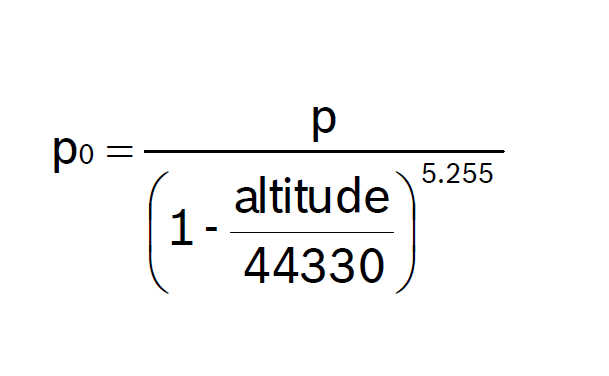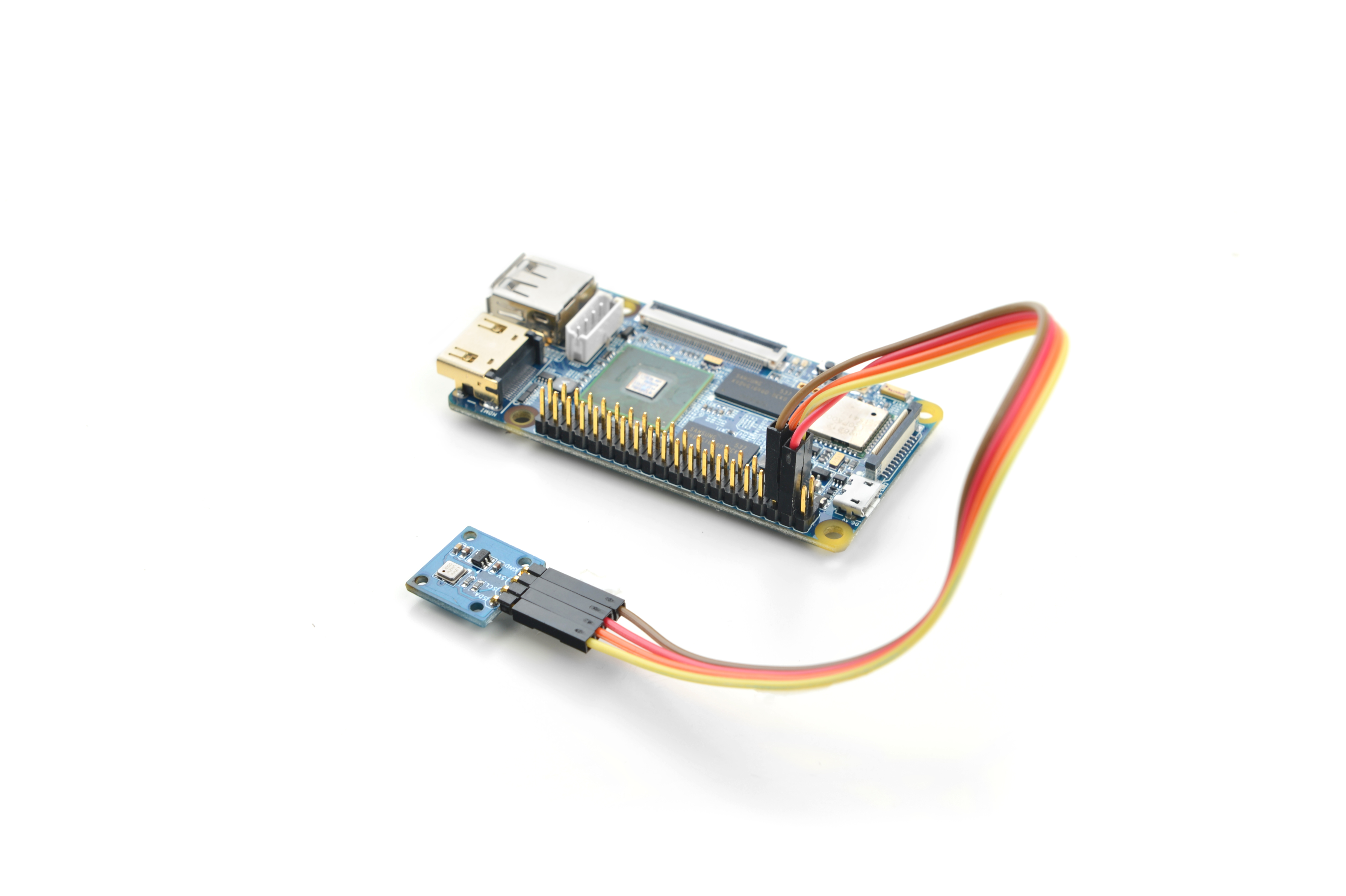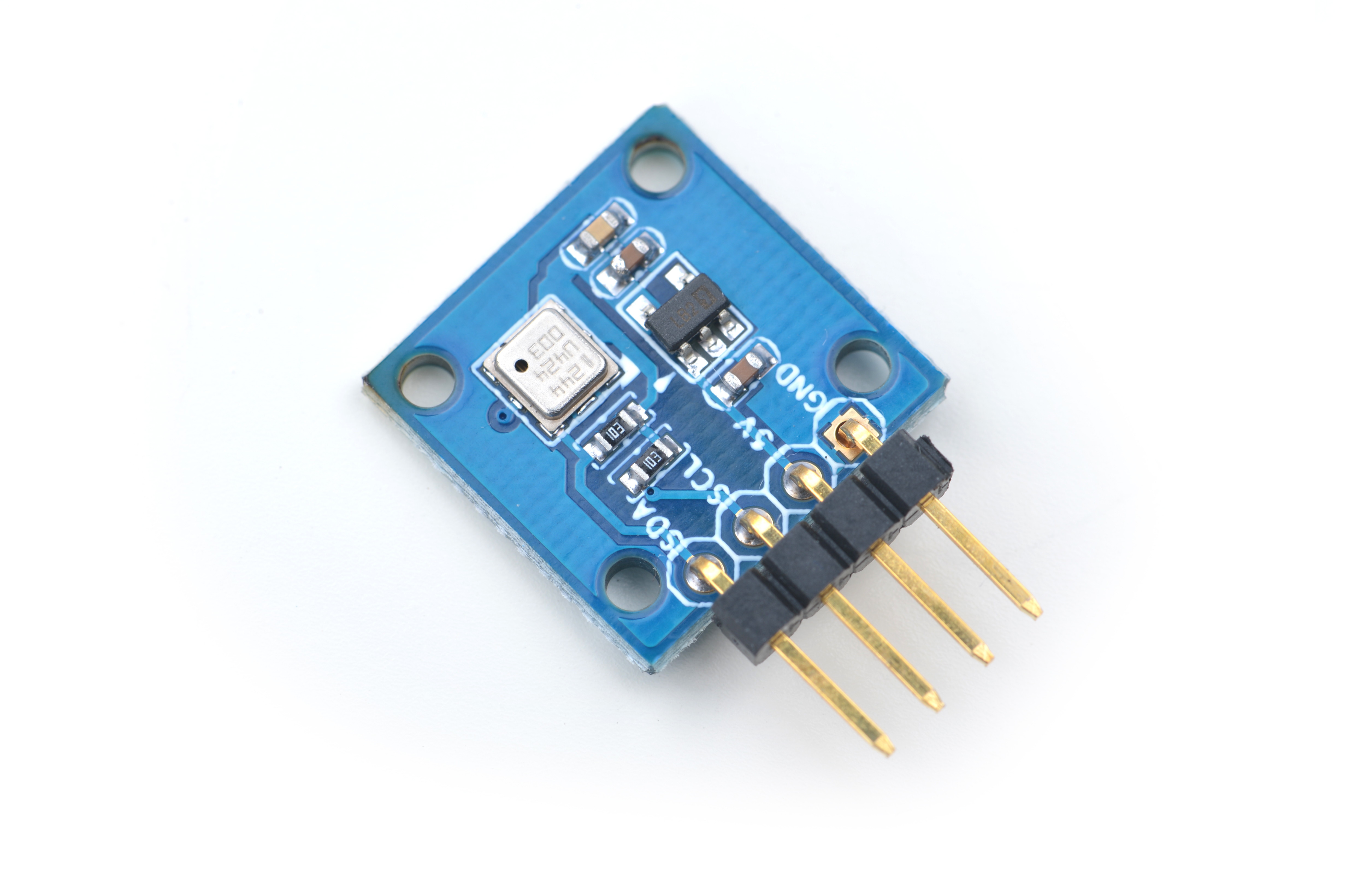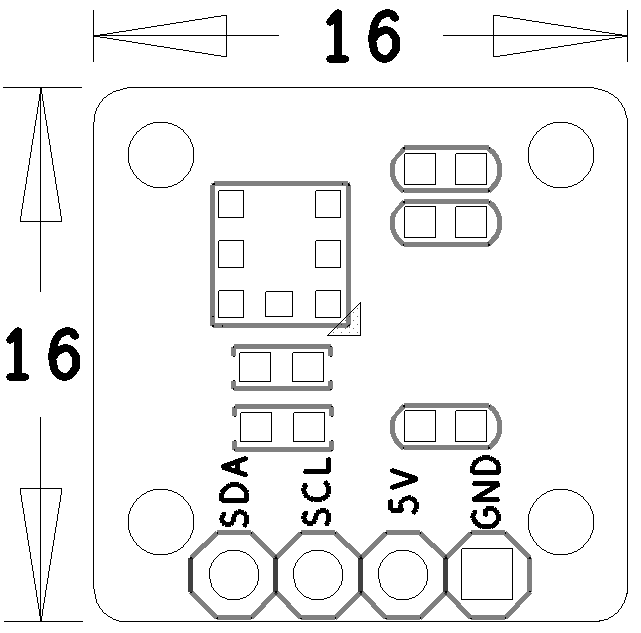Matrix - Pressure and Temperature Sensor
Contents
1 Introduction
- The BMP180 is a high precision, ultra-low power small digital pressure sensor for consumer applications in mobile phones, PDAs, GPS navigation devices and outdoor equipments. With a low altitude noise of merely 0.25m at fast conversion time, the BMP180 offers superior performance. The I2C interface allows for easy system integration with a microcontroller.
- The BMP180 is based on piezo-resistive technology for EMC robustness, high accuracy and linearity as well as long term stability.
- The BMP180 consists of a piezo-resistive sensor, an analog to digital converter and a control unit with E2PROM and a serial I2C interface. The E2PROM has stored 176 bit of individual calibration data. This is used to compensate offset, temperature dependence and other parameters of the sensor.
2 Features
- I2C,3.3V
- Pressure data(16 to 19 bit)
- Temperature data(16 bit)
- PCB Dimension(mm): 16 x 16
- Pin Description:
| Pin | Description |
| SDA | I2C SDA |
| SCL | I2C SCL |
| 5V | Supply Voltage 5V |
| GND | Ground |
3 Basic Device Operation
- The mode (ultra low power, standard, high, ultra high resolution) can be selected by the variable oversampling_setting (0, 1, 2, 3) in the C code.
- Calculation of true temperature and pressure in steps of 1Pa (= 0.01hPa = 0.01mbar) and temperature in steps of 0.1°C.
- With the measured pressure p and the pressure at sea level p0 e.g. 1013.25hPa, the altitude in meters can be calculated with the international barometric formula:

- With the measured pressure p and the absolute altitude the pressure at sea level can be calculated:
 Thus, a difference in altitude of ∆altitude = 10m corresponds to 1.2hPa pressure change at sea level.
Thus, a difference in altitude of ∆altitude = 10m corresponds to 1.2hPa pressure change at sea level.
4 Download Matrix Source Code
All the matrix modules' code samples are open source. They are maintained on GitHub - https://github.com/friendlyarm/matrix.git
Each branch in this hub contains the matrix modules' code samples for a board that the matrix modules can work with.
- The nanopi branch contains the matrix modules' code samples for the NanoPi
- The nanopi 2 branch contains the matrix modules' code samples for the NanoPi 2
- The tiny4412 branch contains the matrix modules' code samples for the Tiny4412
- The raspberrypi branch contains the matrix modules' code samples for the RaspberryPi
Please follow the steps below to get the source code:
Install the git utility on a PC running Ubuntu14.04
$ sudo apt-get install git
Clone the matrix code from GitHub
$ git clone https://github.com/friendlyarm/matrix.git
If this is successful a "matrix" directory will be generated, which will contain all the matrix modules' code samples.
5 Connect to NanoPi 2
5.1 Hardware Connection
Please refer to the following connection diagram to connect the Matrix-Pressure_and_Temperature_Sensor to the NanoPi 2:

Connection Details:
| Matrix-Pressure_and_Temperature_Sensor_nanopi | NanoPi 2 |
| SDA | Pin3 |
| SCL | Pin5 |
| 5V | Pin4 |
| GND | Pin6 |
5.2 Compile Test Program
Please login the matrix hub and enter the nanopi2 branch
$ cd matrix $ git checkout nanopi2
Compile the matrix code
$ make CROSS_COMPILE=arm-linux- clean $ make CROSS_COMPILE=arm-linux- $ make CROSS_COMPILE=arm-linux- install
Note: please make sure to install the cross compiler "arm-linux-gcc-4.9.3" on your PC, which is used to compile files for the NanoPi 2.
Generated library files are under the "install/lib" directory. The test program is under the "install/usr/bin" directory.
The modules are under the "modules" directory. The driver's source code is in github: https://github.com/friendlyarm/linux-3.4.y.git
5.3 Run Test Program
Please insert a TF card which is flashed with Debian to a Linux host and mount its boot and rootfs sections.
We assume the rootfs is mounted to /media/rootfs then please run the following commands to copy the module, library and test program to the card.
$ cp modules /media/rootfs/ -r $ cp install/lib/* /media/rootfs/lib/ -d $ cp install/usr/bin/* /media/rootfs/usr/bin/
Insert this TF card to your NanoPi 2, power on and run the following command to load the driver
$ cd /modules $ insmod bmp085.ko
Start the matrix-pressure_temp program
$ matrix-pressure_tempNote: this module is not plug and play therefore before running the module please make sure it is connected to a NanoPi 2.
Here is what you expect to observe:

5.4 Code Sample
int main(int argc, char ** argv) { int ret = -1; int bmpTemp = 0; int bmpPressure = 0; float altitude = 0; if ((ret = bmp180Read(BMP180_TEMP, &bmpTemp)) != -1) { printf("Get temperature : %.1f C\n", (float)bmpTemp / 10); } else { printf("Faided to get humidity\n"); } if ((ret = bmp180Read(BMP180_PRESSURE, &bmpPressure)) != -1) { printf("Get pressure : %.2f hPa\n", (float)bmpPressure / 100); } else { printf("Faided to get pressure\n"); } altitude = 44330 * ( 1 - pow( ((float)bmpPressure / 100 / 1013.25), (1/5.255) ) ); printf("Get altitude : %.2f m\n", altitude); return 0; }
6 Connect to NanoPi
6.1 Preparations
Please install a Debian on a NanoPi and an appropriate cross compiler on a PC. Please refer to wiki: [NanoPi] & [How to Build the Compiling Environment].
Note: please use the kernel's source code from the nanopi-v4.1.y-matrix branch.
$ git clone https://github.com/friendlyarm/linux-4.x.y.git $ cd linux-4.x.y $ git checkout nanopi-v4.1.y-matrix $ make nanopi_defconfig $ touch .scmversion $ make
After it is done a zImage will be generated under arch/arm/boot/. You can use it to replace the existing file under sd-fuse_nanopi/prebuilt.
6.2 Hardware Connection
Please refer to the following connection diagram to connect the Matrix-Pressure_and_Temperature_Sensor to the NanoPi:
Matrix-Pressure_and_Temperature_Sensor_nanopi
Connection Details:
| Matrix-Pressure_and_Temperature_Sensor_nanopi | NanoPi |
| SDA | Pin3 |
| SCL | Pin5 |
| 5V | Pin4 |
| GND | Pin6 |
6.3 编译测试程序
进入Matrix代码仓库,切换到nanopi分支
$ cd matrix $ git checkout nanopi
编译Matrix配件代码
$ make CROSS_COMPILE=arm-linux- clean $ make CROSS_COMPILE=arm-linux- $ make CROSS_COMPILE=arm-linux- install
注意:请确保你的主机PC当前使用的交叉编译器为NanoPi-Debian配套的arm-linux-gcc-4.4.3。
编译出来的库文件位于install/lib目录下,而测试程序则位于install/usr/bin目录下,模块Matrix-Pressure_and_Temperature_Sensor对应的测试程序为matrix-pressure_temp。
6.4 运行测试程序
将带有Debian系统的SD卡插入一台运行Linux的电脑,可以挂载SD卡上的boot和rootfs分区。
假设rootfs分区的挂载路径为/media/rootfs,执行以下命令将Matrix的硬件驱动、库文件和测试程序拷贝到NanoPi的文件系统上。
$ cp modules /media/rootfs/ -r $ cp install/lib/* /media/rootfs/lib/ -d $ cp install/usr/bin/* /media/rootfs/usr/bin/
将SD卡重新插入NanoPi 2,上电启动,在Debian的shell终端中执行以下命令加载硬件驱动。
$ cd /modules $ insmod bmp085-i2c.ko
运行模块Matrix-Pressure_and_Temperature_Sensor的测试程序。
$ matrix-pressure_temp注意:此模块并不支持热插拔,启动系统前需要确保硬件连接正确。
6.5 Code Sample
int main(int argc, char ** argv) { int ret = -1; int bmpTemp = 0; int bmpPressure = 0; float altitude = 0; if ((ret = bmp180Read(BMP180_TEMP, &bmpTemp)) != -1) { printf("Get temperature : %.1f C\n", (float)bmpTemp / 10); } else { printf("Faided to get humidity\n"); } if ((ret = bmp180Read(BMP180_PRESSURE, &bmpPressure)) != -1) { printf("Get pressure : %.2f hPa\n", (float)bmpPressure / 100); } else { printf("Faided to get pressure\n"); } altitude = 44330 * ( 1 - pow( ((float)bmpPressure / 100 / 1013.25), (1/5.255) ) ); printf("Get altitude : %.2f m\n", altitude); return 0; }
7 与Tiny4412连接使用
8 与RaspberryPi连接使用
9 与Arduino连接使用
10 相关资料
11 Update Log
11.1 Feb-24-2016
- Added the whole English version

